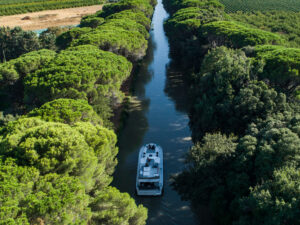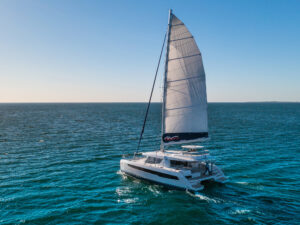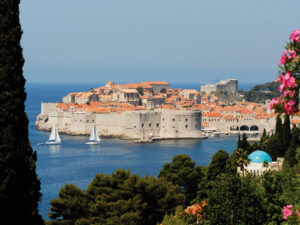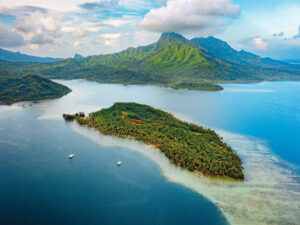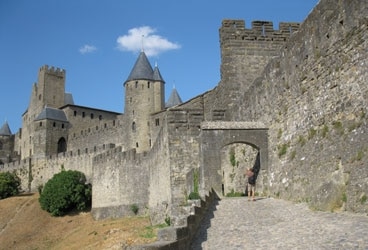
La Cite Medievale
Standing, the petite elderly lady just cleared the top of the glass case of the charcuterie. I could only see her from the eyes up. She asked me to pick a pâté.
“Avec champignons? Foie gras? Pâté de maison?” Choices, choices. So much for a simple run to the grocery store, I thought.
These were my circumstances in Trèbes, a village along the famed Canal Du Midi, the shallow, narrow waterway that stretches loosely east to west in the south of France.
From beneath the colorful striped awnings of waterfront bakeries, butcher shops, and cafés, intoxicating aromas of seafood, garlic, and butter prevailed.
My escape from such low-level hustle and bustle wouldn’t come before a few more deliberate gustatory consultations: Should I buy black olives in salty oil or green olives swimming in brine? Café familial or Jacques Vabre arabica? Fresh goat cheese with local honey, or musky Roquefort with a crisp rosé from a Minervois wine cooperative of the Languedoc-Roussillon region?
I’d faced a similar provisioning challenge the day before, at the farmer’s market in the village of Capestang, with a bread lady. No little old lady she-this compact mademoiselle and her mane of chestnut hair was a ball of fire, and her litanies describing the pain artisinal, the bread that emerged from racks above the flames in a big stone oven in her home in the country, were orchestral flourishes of words and hands.
“Dees loaf,” she pointed to an oval of bleached white, “lasts five days.” Then she held up the whole wheat bread-what the French call complet. “Dees lasts 10. Which you want?”
Both, of course, and while I was at it, anything else savory, quintessentially fresh, and French that I could get my hands on.
Rest assured, this is a story about cruising, not cuisine-sort of. Trust no tale about a week spent on a French canal aboard a self-drive barge boat that omits a lengthy exposé on the subtleties and wonders of food and drink, too. Read on and salivate.
To understand why our crew of 10 would take so willingly to an assignment aboard two lozenge-shaped fiberglass boats more akin to bumper cars than sailing vessels in a largely man-made body of water deemed a World Heritage Site by the United Nations Educational, Scientific, and Cultural Organization requires justification.
After a week of hands-on inspection, my reasoning to all vacation sailors is this: Canal boating is no more akin to powerboating than an Aston Martin is to a Ford Pinto.
The thrill, as any cruiser worth his or her salt knows, is in the journey itself, which includes discoveries, surprises, and side trips by foot and by bike; the chance to make contact with a different culture; and the nearly endless sweeping views of sunflower fields, vineyards, farmhouses, medieval castles, and clock towers. And there’s more: the cooperative and appetite-inducing boathandling and linehandling crew effort required by an ancient locking system that prevails as an engineering pinnacle in a modern age; the meditative, yet cacophonous, chorus of crickets and birds; the perfume-like scents of lavender, basil, and rosemary plucked from the gardens of the lockkeepers along the 240-kilometer way.
According to longtime sailors and canal boaters Pixie Haughwout and Ralph Folsom, in their self-published guide, Canal Cruising in the South of France: The Romantic Canal du Midi (see “Read On,” page 57), even the nautical likes of Tristan Jones did time on the canal, wintering over behind Île Cybelle in the basin bordering the old town of Castelnaudary.
“I decided to stay moored up to the island and let the canal world pass me by. . .I heard the song of the sirens and loved it,” Jones writes in Saga of a Wayward Sailor. Ever the devil’s advocate, ever the doubting Thomas, I had to see Jones’ words in Saga for myself-I needed to consult not just a canal guide but the words of the legendary sailor in the pages of his own work.
Thanks to some dusty shelves in the library at Cruising World, I have my hands on a copy, and after a few easy minutes poking around in the pages, I have the excerpt and then some. Well, well, well. If Tristan could survive a season on the water with the mast down, I fathomed, any self-respecting sailor can handle a week or two, and re-emerge no worse for wear.
By the second half of the 20th century, the brilliant system of locks, aqueducts, bridges with cantenary archways, spillways, drains, and weirs that Pierre Paul Riquet engineered more than 400 years ago to organize water into the canal and link the Mediterranean Sea to the Atlantic Ocean for defense and cargo transport was largely ignored.
The UNESCO designation and a concerted effort on the part of the French government brought new purpose to the canal, converting it into a place of relaxation, outdoor recreation, and tourism.
Today, the Canal du Midi, like other canals in France and throughout Europe, is populated by charter companies, private barge boats, liveaboard boats, small inns and hotels, restaurants, shops, and sundry related service businesses. Towpaths situated alongside the canal are frequented by walkers and cyclists whose panniers are stocked with camping equipment. Wine chateaux along the way advertise, via modest signs, free tastings and sales of the latest cultivation. And if all of this seems a little too much, forget everything and just sit back aboard your boat, raise your eyes, and take in the canopy of leaves from plane trees that are planted in a graceful border embracing the waterway. Nothing is more soothing.
From Sète to Toulouse, communities along the waterway promote festivals, events, and tours of historic sites that give visitors insight into an ancient culture whose lasting influence on Americans is as deep as it is broad.
We were a cross-section of visitors, a group of sailors from the United States who’d never before bareboated on a canal. Our ages, from 6 to nearly 70-a family with young children on one boat and three couples aboard the other-worked to produce a variety of energy and eagerness to absorb this different type of experience with all our senses. The staff of Le Boat-the largest self-drive charter operation in Europe, with bases in several countries-was willing to help us pull off the mission.
At our start point, Le Boat’s base at Port Cassafières, assistant manager Marylise Perilhon and mechanic Jean Michel Segarra took us through the paces, patiently instructing us in all the details concerning lock operations, boathandling.
“You’re traveling through vineyards, and it’s ever so nice,” Marylise said as we sat around a large table and studied the guide provided by the charter company. “You can stop wherever you want-you’re not restricted to an organized harbor.” Armed with the trusty navigational tools of a mallet and a pair of stakes, we could tie the boats to the grassy banks off the towpath, unless we found a tree root that would do. “Stakes and a hammer,” said Van Perry, my cohort in this adventure and the head of marketing for North America with The Moorings charter company. “Well, that’s sort of sailing!”
Aboard our boats, Salsa 2 and Royal Classique 19, both shallow-draft fiberglass vessels whose exterior perimeters are encased in hard bands of black tire-like rubber, Jean Michel showed us how to operate the 40-horsepower Nanni engines and maneuver with the aid of bow thrusters. He assured us that it takes about only an hour for the helmsman to get the feel of the boat.
“After the first lock, it will be easy,” he said. “Just cruise, take it easy, and enjoy. See what happens, and throw the bow and stern into the locks. Don’t try and cheat. If you don’t get it the first time, do the move again. Keep lines ready to use. It’s easy if you take your time.”
In no time, we were under way. Our weeklong, upstream itinerary would take us from Port Cassafières, in the east, to Castelnaudary, 72 kilometers (about 45 miles) from Toulouse, in the west, a total of roughly 157 kilometers and 64 locks. The latter is an impressive number when taking into account the daily hours of operation. Generally, the locks are operational from 9 a.m. until 6 p.m. or 7 p.m., periods that are broken in half by the midday lunch break, a sacred tradition with a duration of one to two hours in France and in countless other motherlands, and one that we’d eventually long to take home with us and adopt in our daily, harried American lives.
As we bumped along at a leisurely six-kilometer-per-hour pace in the greenish-brown water of the channel, which averages a mere seven feet in depth, we worked out the kinks in linehandling and perfected our lassoing methods. The alternating, irregularly staggered pace of locking and cruising would become the rhythm of our lives afloat as we rose through wine country and took in, from the rooftop-like cockpit of the barge-boat design, our front-row view of the spectacular topography of the Languedoc-Roussillon region. It couldn’t have been more pastoral-with the captivating exception of clusters of modern wind-farm towers every few miles or so on the distant hillside horizon, their gleaming white blades turning at a hypnotizing pace.
At the city of Béziers, canal designer Riquet’s birthplace, our first real challenge awaited: There, we’d rise through the seven-lock Fonserannes staircase, after having passed high over the Orb River on the Béziers aqueduct-in effect, this is cruising on a bridge, and it was an amazing, weird sight. And we did it under the hot sun of a long Mediterranean midsummer day, with a twilight that sets in after 9 p.m.
Locking is a matter of taking a boat to higher or lower ground via water; I’ve heard it described as an experience likened to an elevator for boats, but somehow, the vastness of a waterway like the Panama Canal doesn’t call that imagery to my mind. At Fonserannes, we’d ultimately rise 21.5 meters, roughly 70.5 feet, over a distance of 300 meters, the first of many elevation increases on our way to the Le Boat base at Castelnaudary.
Teamwork is critical in locking; in a series of locks such as the Fonserannes staircase, we dropped a crewmember off at the bank before the locks so bow and stern lines could be walked alongside the gates as they swung open.
Overall, it’s a leisurely and social affair, and a centerpiece of the charter. Boats from different companies vie for space inside the locks, which can hold about three to four 40-foot-long boats, but all pleasure craft take second place to commercial vessels. With lockkeepers prevailing over the passage, boats typically fall into a natural, mannerly order in line. Before you know it, you’re making friends with the folks from Belgium ahead of you and the crew from Ireland on the boat behind you.
Locking is also spectator sport; a crowd usually gathers to watch the waters rush in and the boats pass through. Whenever I was dropped off to tend to lines, it made for opportunities to give my rusty schoolgirl French a workout in conversations with lockkeepers and villagers.
And then I got to do my own sightseeing, too, stealing peeks at the gardens of the inns, restaurants, lockkeepers’ homes, and the belowdecks accommodations of some of the fancier crewed or private liveaboard barges. Or at the fancy locking fashions of the female crewmembers-I spied everything from a woman in a purple housecoat to young, red-lipsticked ladies in trendy summer frocks and slipper shoes with jeweled bows. They earned style points in my book for simultaneously looking good and handling lines and boat hooks with aplomb.
Flush from our success at transiting the stairway, our fleet now entered the 54-kilometer lock-free segment called the Le Grand Bief, or the Long Pond, which spans the canal from Fonseranne to Argens Minervois.
We transited the dark, narrow, hand-hewn Tunnel de Malpas, then pulled out the spikes and mallet to tie up the boats at the bank and climb up a nearby hillside to take in a breathtaking sunburst shape of cropland called the Étang de Montady, a marsh that monks drained in the 13th century to grow food.
This was the type of outing that fueled appetites, and we dined on baguettes, cheeses, saucissons, pâtés, salads, and local wine while under way. Did our taste buds distract us? Probably. At one point, we ducked just in time while passing under a low bridge, nearly beheading our umbrella. We received a bemused look from an elderly gent in a beret, who winked at us as he stopped his morning stroll to point to his own head and call out “Gardez la tête! Gardez la tête!”
Days passed too quickly, and we made our way past more enchanting spots to tie up for the night, more charming villages and markets and people and wineries and cathedrals than we could squeeze into a weeklong visit.
As we vowed to return “in a heartbeat,” we ticked off the stops, the sights, and adventures of the Long Pond and beyond: watching the elderly ladies walk to the market at Capestang and visiting with vendors there; romping through sunflower fields and “borrowing” a few for table centerpieces; taking frequent bicycling trips into village centers for provisions, along the towpath for exercise, and exploration; a stop for a taste and a lecture with Monsieur Tastavy at his family’s 400-year-old winery, Domaine de Guery; and the magical tour of the medieval La Cité de Carcassonne, Europe’s largest restored fortified city and UNESCO World Heritage Site.
True enough, canal yachting doesn’t meander in the way of coastal cruising or destination bareboating. Rather than checking a chart for reefs, rocks, tides, and current, you scan the guidebook to gauge the number of locks ahead, betting arrival time against the lockkeeper’s lunch hour. You trade in anchor for mallet and stake; what you give up in canvas, you make up for in the frequent tossing, catching, and walking of lines.
You’re committed to a fairly narrow-some 60 feet or less across-linear channel and a route; no secluded anchorages call out. But no matter who you chat with or what you read or who you meet along the way, this is an experience that could never be repeated or become ordinary.
Well, almost never repeated, and certainly never ordinary. For when we arrived at our final destination, the Le Boat base at Castelnaudary, the sun beat down hard. The crews were hot and thirsty and threatened mutiny if consigned to spending the long evening hours alongside the rest of the exposed charter fleet.
Next thing I knew, our boat’s captain and my longtime partner, Rick Martell, spied shade in the west end of the Grand Bassin, under the sweeping branches of mulberry trees that bordered both the municipal quays and a tiny islet. We powered over and tied up, tout de suite.
“Hey!” Rick said later. “Guess where we are? Île Cybelle, the place Tristan Jones tied up for the winter.”
Need I write it? If it was good enough for Tristan, I know now and you know now that it surely was good enough for us, too.
Elaine Lembo, CW’s deputy editor, also writes about chartering.

